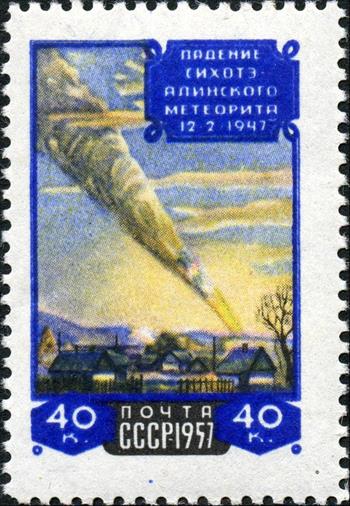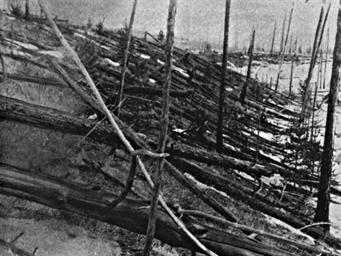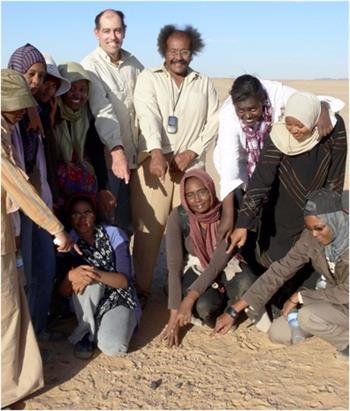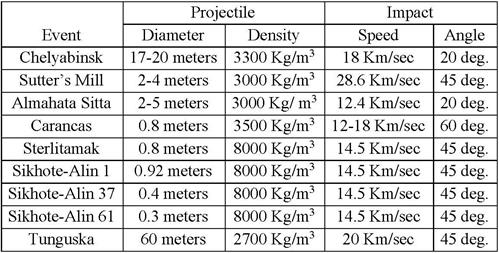Aerospace Micro-Lesson #64
In This Section
Asteroid Day
On June 30, 1909 (by the Gregorian calendar), a large astronomical object—either a meteor, a comet, or something similar—exploded over Tunguska, Russia, devastating an area of almost 2,000 square miles. In commemoration of that event and as a means of raising consciousness about the dangers of other asteroid strikes, the United Nations has proclaimed June 30 of each year to be Asteroid Day. This lesson describes some meteorite impacts since Tunguska.
Next Generation Science Standards (NGSS):
- Discipline: Earth and Space Sciences
- Crosscutting Concept: System and System Models
- Science & Engineering Practice: Developing and Using Models
GRADES K–2
NGSS: Earth and Space Systems: Use information from several sources to provide evidence that Earth events can occur quickly or slowly.
On Wednesday, February 12, 1947, around 10:30 in the morning, an artist named P.I. Medvedev was sitting in his studio in the small town of Iman, in the Soviet Union, beginning a sketch. As he looked out the window, he saw a brilliant fireball fly past, high in the distant sky, leaving a trail of smoke. “Hmm,” he said to himself, “I think I’ll draw that.” (At least, that is very likely what he said to himself.) He did draw it and his picture became famous. The Soviet government used it ten years later on a postage stamp that commemorated the event.
What Mr. Medvedev had seen was the fall of the Sikhote-Alin meteor in the eastern Soviet Union. Many other people in the area also saw it fall. As it fell, the meteor broke up into many smaller pieces; these pieces hit the earth—out in a remote area, thankfully, so nobody was hurt. The Sikhote-Alin meteorite, as the collection of pieces is known, is the largest meteorite that has been recovered. (When an object from space is falling through the atmosphere, it is called a meteor; after it has hit the Earth, it is called a meteorite. While it is still out in space before it reaches the Earth, it is called a meteoroidor, if it is fairly large, an asteroid.) Scientists have estimated the weight of the meteorite—all the pieces added together—to be about 70 tons, or 140,000 pounds.
Even though the place the meteorite hit was quite remote, the Soviet government organized expeditions to go and find the site and explore it. These expeditions found trees that small pieces of hot rock had hit and broken off branches, craters where pieces of the meteorite had hit the ground and dug holes, and pieces of the meteorite itself. The largest crater they found was 85 feet across and almost 20 feet deep! You can buy pieces of the meteorite as curiosities.
Large as that is, Sikhote-Alin is not the largest meteor to have hit the Earth in recent history. That honor goes to something that came into the atmosphere from space over Tunguska in Russia on June 30, 1908. The Tunguska site was so remote that nobody was able to get to it for almost twenty years! The meteor did not hit the surface of the Earth; instead, it exploded high in the air and tiny fragments landed over a wide area. The force of the explosion knocked down trees in an area of 800 square miles—up to a distance of twenty miles away. The picture above was taken by Leonid Kulik, who was the person who led the expedition to Tunguska nineteen years after the event. The nearest town was about 40 miles away and suffered some damage, but apparently only one person was killed by the explosion. The BBC published a 100th anniversary storyabout the event. An article by NASA includes the description from an eyewitness: “Suddenly in the north sky… the sky was split in two, and high above the forest the whole northern part of the sky appeared covered with fire… At that moment there was a bang in the sky and a mighty crash… The crash was followed by a noise like stones falling from the sky, or of guns firing. The earth trembled.”
GRADES 3–5
NGSS: Earth and Space Systems: Support an argument that differences in the apparent brightness of the sun compared to other stars is due to their relative distances from the Earth.
Late Sunday night, on October 5, 2008, astronomers at the Mt. Lemmon Observatory in Arizona noticed a dot of light in the sky that was moving relative to the stars. (The official date and time of the discovery are October 6 at 6:39 GMT, but the difference in time zones made it late the previous night in Arizona.) Only objects within the Solar System move relative to the stars. They reported it to the Minor Planet Center, which is a clearing-house for this sort of observation. The Minor Planet Center alerted astronomers around the world. Within a few hours, three other observatories—one in Arizona and the others in Australia—had spotted the object and the astronomers were able to tell how far away it was and in which direction it was moving. Quick calculations of its orbit showed that it would collide with the Earth over northern Sudan in Africa the next morning, around 2:45 AM GMT. In Sudan’s time zone, that was around 4:45 AM, or about an hour before sunrise.
Word of the newly-discovered asteroid spread rapidly around the world through e-mails from the Minor Planet Center. As they moved into nighttime, astronomers in different parts of the Earth trained their telescopes on the asteroid and watched its motion. Some also monitored its brightness and got an idea of how quickly it was rotating. In all, 26 observatories—both professional and amateur—around the world sent 570 observations of the object’s position in space, allowing the Minor Planet Center to refine its estimates of the orbit.
The meteor itself entered the Earth’s atmosphere almost exactly when and where it had been predicted the day before. The time had been predicted as 2:45:40 GMT, to the nearest second; the actual time was a second and a half earlier than that. The position had been predicted to the nearest tenth of a degree, or about seven miles; the actual place where the asteroid entered the atmosphere was within the uncertainty of the prediction. (This would be a good place to mention significant figures.) The pilot of a KLM (the Dutch airline) flight from Nairobi to Amsterdam had been told to look out his window forward and to the right around 4:46 AM; he did and he saw the meteor. The meteor was also photographed by several Earth-observing satellites that were overhead at the time. Prof. Muawia Shaddad of the University of Khartoum went outside at dawn and photographed the dust trail that the meteor had left.
Two months later, Prof. Shaddad, several of his students, and a visiting meteorite scientist from NASA organized an expedition out into the Sahara Desert to look for meteorite fragments. They found many small pieces, the largest about the size of an egg. This was the first time in history that an asteroid had been seen out in space, then seen as a meteor falling through the Earth’s atmosphere, and then found in pieces as a meteorite on the Earth’s surface. The asteroid was (briefly) named 2008 TC3 and the meteorite is named Almahata Sitta, after the place where it fell.
Not all meteors make craters or fireballs or are even noticed as they fall. There is a continuous “rain” of micrometeoroids (space “dust” grains that weigh less than a gram each, often much less than a gram) on the Earth; in fact, about 100 tons of dust falls to Earth every day. (Before you start thinking that this is a lot, please remember that the surface area of the Earth is about 5×1014 square meters—feel free to have the students do the math—and so this comes to a flux of about one gram every five square kilometers per day. It is also worth noting that this estimated rate varies by an order of magnitude; we just don’t know the exact amount.) This space dust provides nucleation centers, tiny solid surfaces that raindrops and ice crystals can form around to start the condensation process. In particular, noctilucent clouds form when water vapor high in the atmosphere forms ice crystals around micrometeoroids.
GRADES 6–8
NGSS: Earth and Space Systems: Analyze and interpret data to determine scale properties of objects in the solar system.
On Saturday, September 15, 2007, people in the small village of Carancas, Peru were getting ready for lunch when they heard a loud thump, or perhaps even an explosion, nearby. The explosion kicked a large cloud of dirt into the air. Their first thought was that the Chileans were attacking—Peru and Chile have had rocky relations for a long time—but when they heard no further noises they went out to investigate. They found a 40-foot-wide crater in the bank of a nearby stream. A few brave souls climbed down into the crater to see what they could find there. People standing nearby smelled a sickly-sweet odor. A small meteorite had fallen on the stream bank just outside of the village.
Scientists from around the world came to Carancas to study the impact and the crater. By carefully recording what had happened, they were able to put together quite a bit of data. A man riding a bicycle nearby was knocked over by the force of the blast when the meteorite hit, but he was not hurt; this put a lower bound and an upper bound on the strength of the blast. A bull standing nearby was also knocked over; this put another lower bound on the strength. Another man standing farther away felt the wind from the blast against him but was not knocked over; this put another upper bound on the strength. A nearby shed was not damaged by the blast—although its roof was dented by a rock that was thrown up from the crater. ( The link has pictures of the crater, the men, the bull, and the shed, by the way.)
Thirty of the people in Carancas fell ill after visiting the just-formed meteor crater. After some investigation, scientists figured out that the heat from the impact had boiled some of the local groundwater which contained arsenic; arsenic is poisonous. This had been the source of the odor that the people had smelled at the crater. They all recovered within a few days.
If you find a rock and think it might be a meteorite, you will need to examine it carefully. Many rocks that look like meteorites aren’t. There is a handy flowchart for figuring out whether or not a given rock actually fell from the sky. (This can be useful practice in following a process and using if-then logic.)
With the examples of meteorites hitting the Earth in the last century, scientists have come to realize that a large meteorite can pose a serious threat. The Tunguska event devastated hundreds of miles of forest; had it hit near a city, it would have caused great destruction. The Earth’s surface shows scars from the impacts of even larger meteorites: theMeteor Crater in Arizona and Lake Manicougan in Quebec are just two of many examples. Any of these larger impacts would easily have destroyed everything within miles of where they hit. To address this threat, scientists have started theNear Earth Object Search Program with a goal of discovering anything in space that orbits the Sun near the Earth and which might possibly threaten the Earth if it hits us. They are doing quite a good job of it.
GRADES 9–12
NGSS: Earth and Space Systems: Use mathematical or computational representations to predict the motion of orbiting objects in the solar system.
Three astronomers have assembled the conventional wisdom and mathematical models of meteorite impacts into a very handy web-based program called the Earth Impact Effects Program. To use the program, one enters one’s distance from the impact point, a couple of characteristics of the asteroid, its impact parameters, and the type of surface (hard rock, soft rock, or water) that it hits. The program estimates how often something of this size hits the Earth; how it travels through the atmosphere; the energy released; crater dimensions; the size and radiation of a fireball created by the explosion; and local effects such as air blast and ground shock. A link on the page leads to a scientific paper that describes the equations used to come by the estimates. It is important to remember that the answers, even though they are given to three significant figures, are still estimates. Here is a quote from the paper: “For impacts into water, the constant 1.161 must be replaced by 1.365 (Schmidt and Housen 1987). In reality, these constants are not known to three decimal places; the values quoted serve as a best estimate within a range of 0.8 to 1.5.” You may want to run the program with parameters from various recent impact events:
It is worth repeating that many of these parameters are estimated after the fact from data such as crater dimensions, air blast pressures, and other post-impact information. It is also worth repeating that the answers that the program gives are estimates, outputs from approximate models. For example, the program will say that the Carancas asteroid exploded in the atmosphere and did not cause a crater; this is simply wrong and stems from a combination of model inaccuracies and the fact that the Carancas impact site is at very high altitude above the thickest part of the atmosphere.
The biggest asteroid impact story is the one that is not going to happen any time soon. In June 2004, three astronomers at the Kitt Peak National Observatory discovered an asteroid that was first called “2004 MN4” but was later given the permanent name of “99942 Apophis.” The “99942” means that it was the 99, 942ndasteroid to be given a permanent name; the name by which it is known is simply “Apophis.” The Kitt Peak observers saw the asteroid for two nights only; after that it was lost for six months until an observatory in Siding Spring, Australia rediscovered it. A preliminary calculation of Apophis’ orbit showed that it might hit the Earth in 2029. The risk was small, only about one chance in 37, but its diameter was estimated at around 400 meters, large enough to make a crater more than three miles wide if it hit the Earth. The asteroid was the first object to be given a rating of two on the Torino Impact Hazard Scale.
Within a few months, some pre-discovery pictures (astronomical photographs in which it appeared but had not been noticed before) of Apophis were found and used to calculate a more accurate orbit. The new orbit showed the asteroid passing a mere 18,300 miles above the surface of the Earth—half the previously-calculated distance—but the uncertainty in its position had been reduced to the point that there was no chance of an impact. The date of closest approach will be on Friday, April 13, 2029. Further observations also refined the estimated radius to be about 320 meters, a reduction of 20 percent from the first estimate.
In addition to the close approach in 2029, there was also a concern about a second close approach in 2036. The problem was that the approach in 2029 will perturb Apophis’ orbit, greatly increasing the uncertainty in its position seven years later. Astronomers spoke of a “keyhole” in space near the Earth which, if Apophis passed through it in 2029, would set it on a collision course with the Earth in 2036.
In 2013, when Apophis passed near the Earth, astronomers measured its position again. With the new observations, the concerns were finally put to rest. On Friday, April 13, 2029, Apophis will pass 18,300 miles above the Earth’s surface, giving its most spectacular show (a dot of light moving the distance of about a lunar diameter every 30-40 minutes) to observers in Europe and Africa. Seven years later, on Easter Sunday, April 13, 2036, it will pass by the Earth again at a comfortable distance of about 36 million miles. After that, no close approaches are predicted any time in the next few centuries.
On into the very distant future, though, nothing can be ruled out.
Sixty Years Ago in the Space Race:
June 26: The American Vanguard SLV-2 was launched but did not reach orbit because of an early engine shutdown.
June 27: After 93 days in space, the American satellite Explorer III re-entered the Earth's atmosphere.




